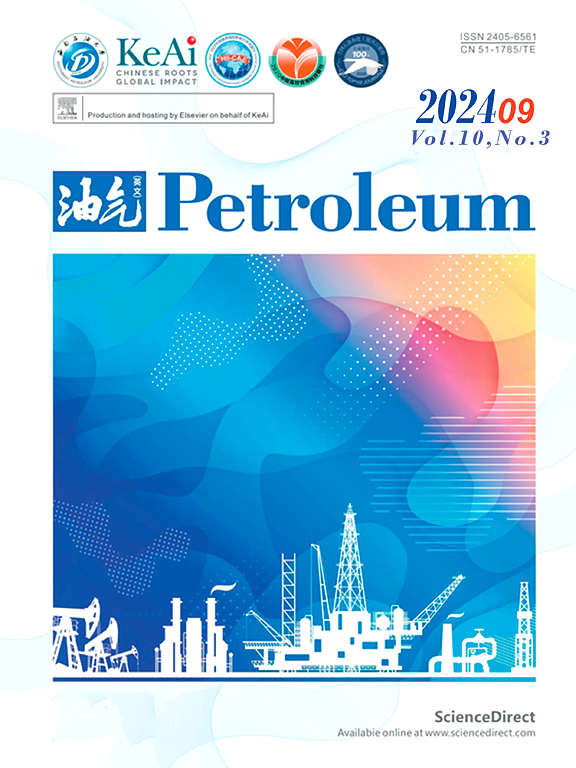Insights into the application of microfluidic platforms in enhanced oil recovery
IF 3.5
Q2 ENERGY & FUELS
引用次数: 0
Abstract
Enhanced oil recovery (EOR) technologies are used to recover most of the trapped crude oil from our limited reserves. With the escalating energy demand, EOR will achieve substantial economic benefits and greatly help in the exploitation of natural oil reserves. Recent research focused on microfluidic platforms for studying flow behavior during EOR flooding. These platforms are micro-sized, and allow processing and visualization of a minimal amount of fluid, making them an intriguing tool for studying the microscale phenomena in EOR processes. This review presents a comprehensive and concise literature on microfluidic trends and developments in EOR. A particular focus is on the use of these platforms to assess oil recovery via chemical-based flooding methods, to understand the associated emulsification mechanisms, and to mimic subsurface morphology and mineralogy of reservoirs. Furthermore, an outlook on the advancement of microfluidics utilization in EOR applications is discussed, covering development efficient micro-scale separators, 3D printing, and Artificial Intelligence applications. Microfluidic platforms provide valuable insights into EOR processes, and ongoing advancements in microfluidics hold the potential to enhance oil recovery efficiency and optimize EOR techniques.
微流控平台在提高采收率中的应用
提高原油采收率(EOR)技术用于从有限的储量中开采大部分被困原油。随着能源需求的不断增长,提高采收率将取得可观的经济效益,对天然石油储量的开发有很大的帮助。最近的研究主要集中在微流体平台上,用于研究提高采收率过程中的流动特性。这些平台是微型的,可以处理和可视化最少量的流体,使其成为研究提高采收率过程中微尺度现象的有趣工具。本文综述了微流体技术在提高采收率中的发展趋势。特别关注的是利用这些平台通过化学驱法评估采收率,了解相关的乳化机制,并模拟储层的地下形态和矿物学。展望了微流体技术在提高采收率中的应用前景,包括开发高效的微尺度分离器、3D打印和人工智能应用。微流控平台为提高采收率过程提供了有价值的见解,微流控技术的不断进步有可能提高石油采收率并优化提高采收率技术。
本文章由计算机程序翻译,如有差异,请以英文原文为准。
求助全文
约1分钟内获得全文
求助全文
来源期刊

Petroleum
Earth and Planetary Sciences-Geology
CiteScore
9.20
自引率
0.00%
发文量
76
审稿时长
124 days
期刊介绍:
Examples of appropriate topical areas that will be considered include the following: 1.comprehensive research on oil and gas reservoir (reservoir geology): -geological basis of oil and gas reservoirs -reservoir geochemistry -reservoir formation mechanism -reservoir identification methods and techniques 2.kinetics of oil and gas basins and analyses of potential oil and gas resources: -fine description factors of hydrocarbon accumulation -mechanism analysis on recovery and dynamic accumulation process -relationship between accumulation factors and the accumulation process -analysis of oil and gas potential resource 3.theories and methods for complex reservoir geophysical prospecting: -geophysical basis of deep geologic structures and background of hydrocarbon occurrence -geophysical prediction of deep and complex reservoirs -physical test analyses and numerical simulations of reservoir rocks -anisotropic medium seismic imaging theory and new technology for multiwave seismic exploration -o theories and methods for reservoir fluid geophysical identification and prediction 4.theories, methods, technology, and design for complex reservoir development: -reservoir percolation theory and application technology -field development theories and methods -theory and technology for enhancing recovery efficiency 5.working liquid for oil and gas wells and reservoir protection technology: -working chemicals and mechanics for oil and gas wells -reservoir protection technology 6.new techniques and technologies for oil and gas drilling and production: -under-balanced drilling/gas drilling -special-track well drilling -cementing and completion of oil and gas wells -engineering safety applications for oil and gas wells -new technology of fracture acidizing
 求助内容:
求助内容: 应助结果提醒方式:
应助结果提醒方式:


